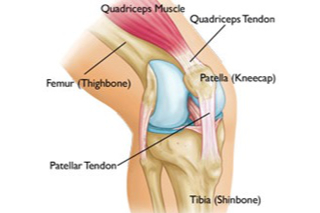The knee joint consists of the shinbone (tibia) and the thigh bone (femur) and the kneecap (patella). This is the bone, at the front of the knee, that is in the tendon of the large quadriceps muscle (M. quadriceps). The M. quadriceps runs at the front of the thigh (femur) to the shinbone (tibia). This construction allows you to extend the leg. The kneecap has a kind of lever action where it increases the strength of the M. quadriceps. The bottom and back of the kneecap are covered with cartilage. The cartilage ensures that the kneecap has a smooth surface, to easily move in the special groove on the top (femur).
Many knee complaints arise when the cartilage of the kneecap becomes irritated or wears out (degenerates). This is usually called chondromalacia or chondropathy.
Wear and tear is part of aging, but can sometimes be the cause of complaints. The most common cause of kneecap complaints originates in how the kneecap moves in the groove of the thigh bone (patello-femoral groove). This can be subdivided into 3 groups:
In the first two points, the kneecap will experience incorrect traction from the M. quadriceps. This will pull the kneecap more to one of the two sides. Usually this is to the outside, where more pressure will be exerted on the cartilage, which can lead to irritation or wear. In any case, the kneecap no longer “tracks well” in the groove.
Typical for people with patello-femoral complaints is the pain when walking downhill and climbing stairs, or keeping that knee bent for a long time (long car rides). Sometimes you can hear the knee “grinding” when climbing stairs or the kneecap clicks when bent. This is because the rough cartilage surfaces of the kneecap and the groove on the femur rub against each other. The knee joint can respond to this irritation with swelling and inflammatory symptoms.
A practitioner can check the position and rolling of the foot, ankle and knee during the examination. When the ankle rolls too far inwards (overpronates) while walking, this has an effect on the knee. The knee will therefore rotate more inwards (endrotate), the kneecap will be pulled more outwards and will start to run against the outer edge of the patello-femoral groove. This causes pain and possibly wear and tear of the knee in the long run. Excessive walking outwards (supinating) can also cause these complaints. The practitioner can then correct the foot position or foot rolling with the help of therapeutic insoles, possibly with additional shoe advice. Collaboration with physiotherapy is possible to train the M. quadriceps.
